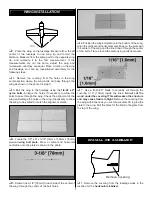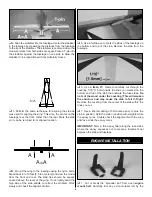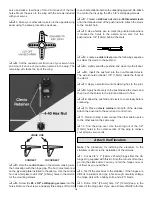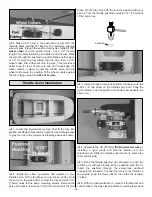
capabilities. In any case, please start at the location we
recommend. Do not at any time balance your model outside
the recommended range.
❏
2. With the wing attached to the fuselage, all parts of the
model installed (ready to fly), and an empty fuel tank, block
up the tail as necessary to level the stab. Lift the model at
the desired balance point, and observe the tail of the
aircraft. If the tail drops, the model is “tail heavy” and you
must add weight* to the nose to balance the model. If the
nose drops, it is “nose heavy” and you must add weight* to
the tail to balance the model.
Note:
Nose weight may be easily installed by using a
“spinner weight.” Tail weight may be added by using Great
Planes (GPMQ4485) “stick-on” lead weights.
* If possible, first attempt to balance the model by changing
the position of the receiver battery. If you are unable to
obtain good balance by doing so, then it will be necessary to
add weight to the nose or tail to achieve the proper balance
point. Remember to secure the receiver and battery after
your model has been balanced.
IMPORTANT:
Do not confuse this procedure with “checking
the C.G.” or “balancing the airplane fore and aft.”
Now that you have the basic airplane nearly completed, this
is a good time to balance the airplane laterally (side-to-side).
Here is how to do it:
❏
1. Assemble the model as in preparation for flight. (No
fuel is required for this procedure.)
❏
2. With the wing level, lift the model by the engine
propeller shaft and the fin post (this may require two
people). Do this several times.
❏
3. If one wing always drops when you lift the model, it
means that side is heavy. Balance the airplane by adding
weight to the opposite, lighter wing tip.
Note:
An airplane that has been laterally balanced will track
better in loops and other maneuvers.
Computer Radios.
As you prepare to fly the Giles G-202
ARF for the first time, there are a few features on computer
radios we’d like to mention. There are many others, of
course, but these are commonly used features on most
computer radios. If you are using a non-computerized radio,
this information may still be of interest to you for future
installations.
ATV or Travel Volume:
ATV is a wonderful feature of
computer radios which allows you to make minor
adjustments to how far a servo travels at its extremes. For
example, you install the throttle pushrod, and it’s almost
perfect, except you have some binding at wide open.
Instead of struggling with the clevises to try to keep full
throttle but not have the binding, you can turn down the ATV
slightly until the binding is gone.
Why only adjust ATV slightly?
Control linkages are really
just a lesson in leverage. The less distance the servo is
moving for a given throw at the surface, the less leverage
you have given the servo to do the job. Thus the lower you
set the ATV, the less power you are leaving for the servo to
apply to the surface. Additionally, a servo has only so many
points within its range of motion. By cutting its range in half,
you’ve also diminished the precision of the servo by 50%.
Because of both of these issues, we strongly recommend
setting the high rates as close as possible to 100% on the ATV.
Dual Rates:
Setting dual rates helps make your model
easier to fly in a variety of situations. For example, an expert
pilot who wants to do torque rolls will need a large amount
of control throw. However, he does not want that same huge
volume of throw when he is trying to do smooth loops or
slow rolls. Low rates give your model a soft feel, with
aggressive responsiveness just a flip of a switch away.
Exponential, the best of both rates:
Exponential is a feature
which modelers tend to either love or hate. The benefits of
exponential are that they make the elevator, for example,
feel like it is on low rates when you are moving the stick near
center; however, when you get farther from center the model
gets progressively more responsive. The reason this is
helpful is that it allows you to make soft, minor adjustments
when small corrections are needed, but still allows you
sufficient throw to make major changes at full stick. For example,
you can smoothly level the wings while flying along straight
and level without over-controlling, yet still have enough
aileron throw at full stick to complete a one-second roll.
Idle Down and Throttle Kill:
Idle down allows you to have a
switch set for a high idle, ideal for most aerobatics where
you have little or no risk of dead sticking, as well as a lower
idle setting for, say, landings, taxiing, and minimum throttle
maneuvers such as spins. The throttle kill setting on most
computer radios will idle your engine down whatever
percent you set it so that your engine will shut off when the
switch is thrown AND the throttle stick is in the idle position.
This is an excellent safety feature to shut off your engine in
emergency situations. If you are utilizing a gasoline engine,
you can mix your electronic kill switch to your throttle kill
position for consistency.
ADVANCED AEROBATICS
Balance Your Model Laterally
21








































